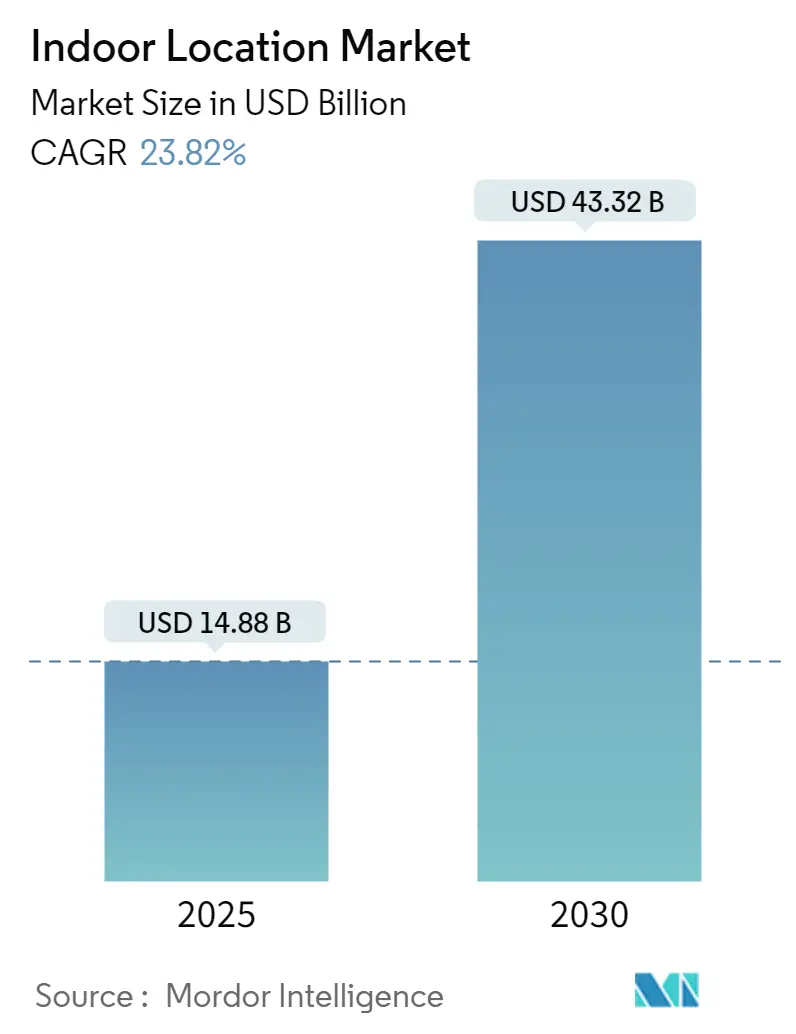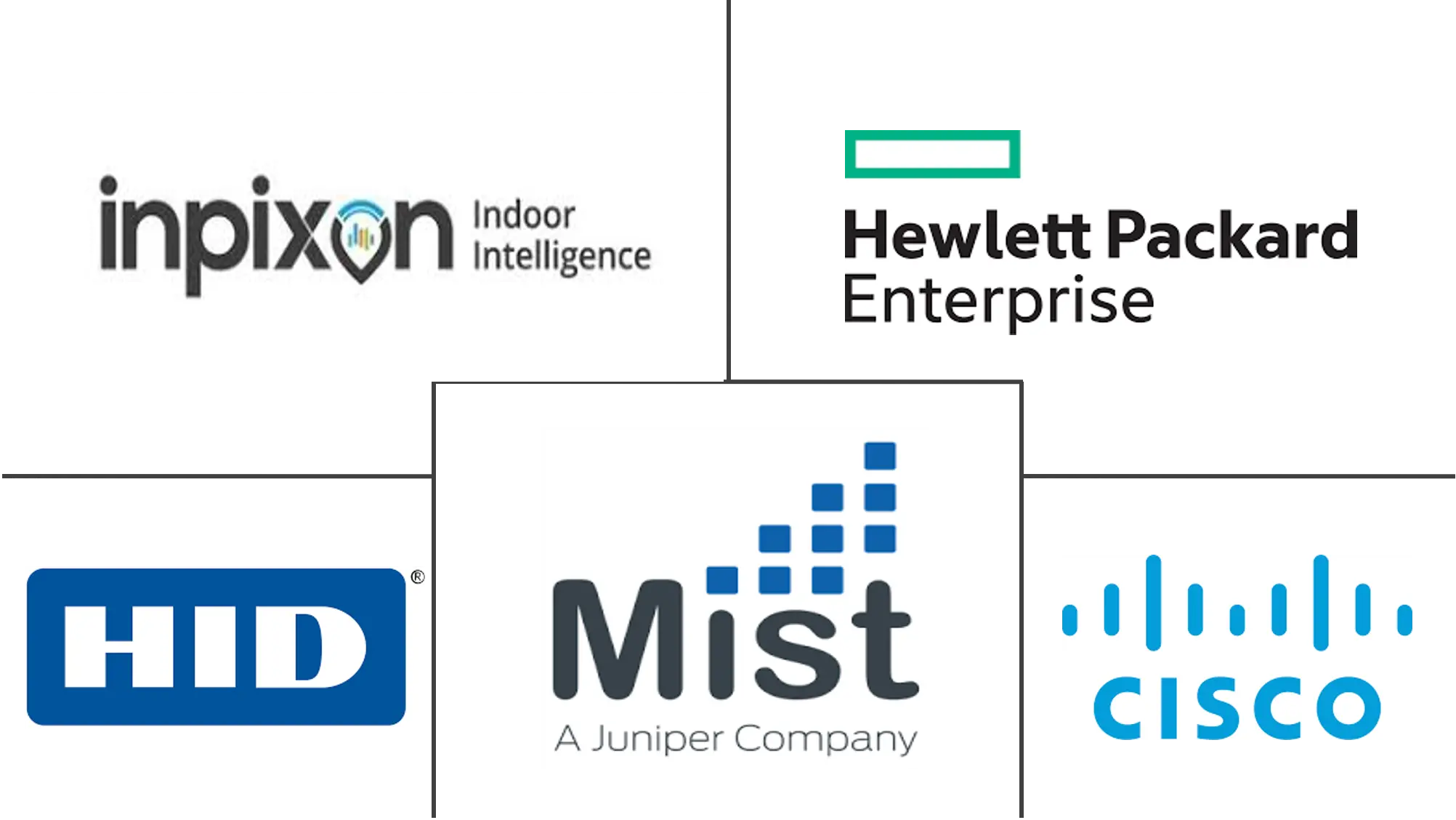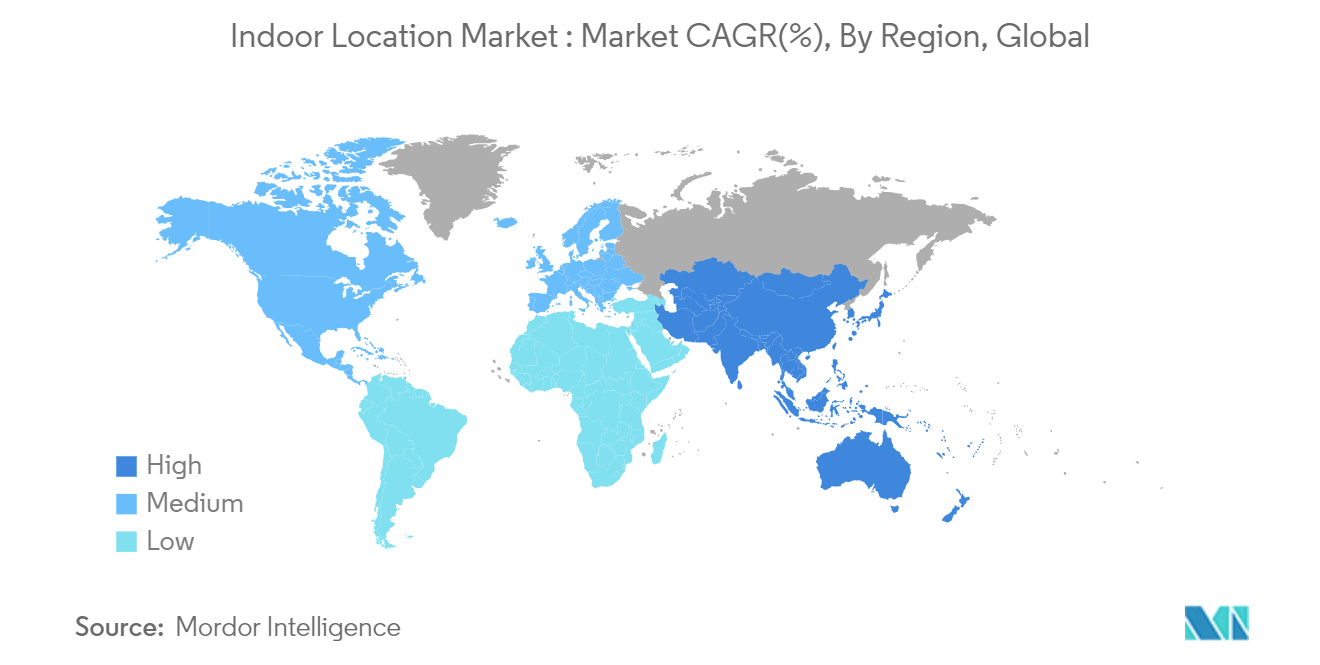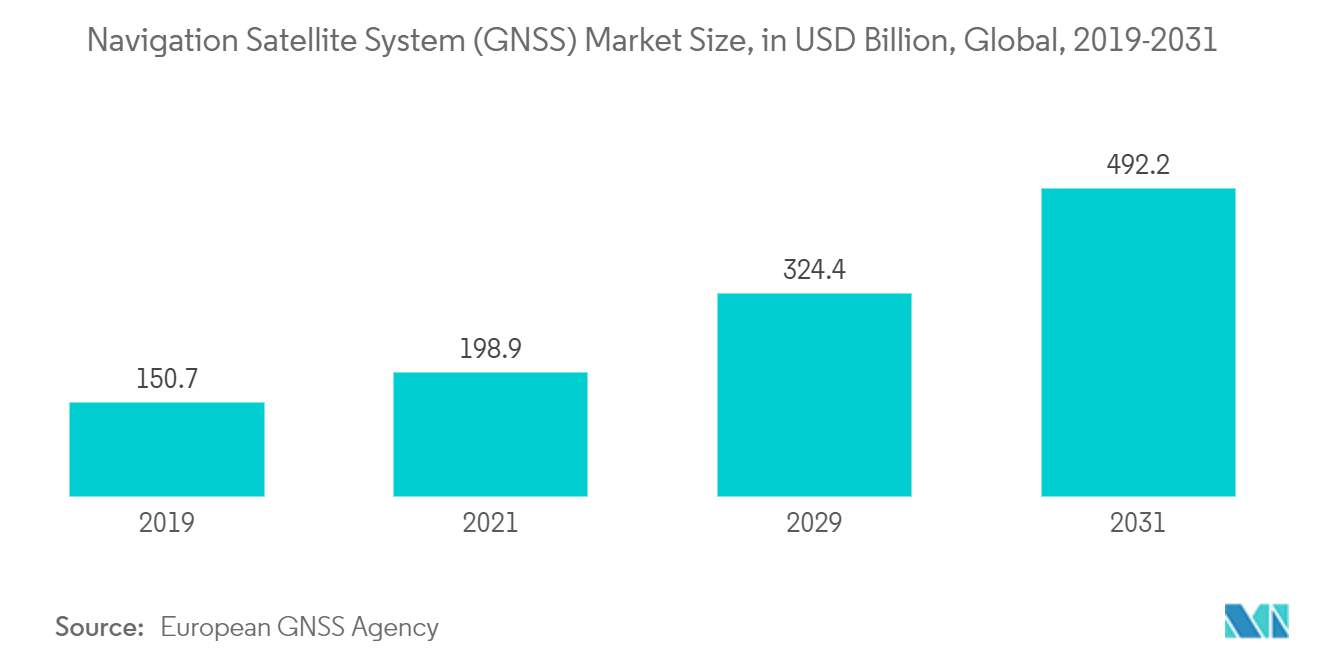
| Study Period | 2019 - 2030 |
| Market Size (2025) | USD 14.88 Billion |
| Market Size (2030) | USD 43.32 Billion |
| CAGR (2025 - 2030) | 23.82 % |
| Fastest Growing Market | Asia Pacific |
| Largest Market | North America |
| Market Concentration | Low |
Major Players
*Disclaimer: Major Players sorted in no particular order |
Indoor Location Market Analysis
The Indoor Location Market size is estimated at USD 14.88 billion in 2025, and is expected to reach USD 43.32 billion by 2030, at a CAGR of 23.82% during the forecast period (2025-2030).
- Indoor positioning systems (IPS) are stepping in where traditional GPS falls short, especially in complex environments like multistory buildings, airports, and underground parking lots. These systems, comprising a network of devices, are proving crucial in pinpointing people or objects.
- Businesses, irrespective of their size, are increasingly turning to indoor location systems for enhanced precision. These systems not only aid in precise tracking but also assist production facilities in optimizing their floor space. The surge in applications leveraging beacons, Bluetooth BLE tags, and even integrating with camera equipment, point-of-sale (POS) systems, and digital signage is propelling the indoor location market's growth.
- Businesses are swiftly adopting cloud computing and IoT for streamlined operations, with the healthcare sector leading the charge. The sector is poised for substantial growth as healthcare IoT applications align more closely with medical needs.
- Furthermore, the market for indoor spaces is expected to expand, driven by the rising demand for smartphones with advanced applications, the push for digitalization, and ongoing technology enhancements.
- However, challenges loom. Incompatibilities among infrastructures, interoperability issues, and concerns over data security are casting shadows on end users. Additionally, maintenance challenges could impede market growth.
Indoor Location Market Trends
Transportation and Logistics Vertical to Hold a Dominant Market Share
- The growth can be attributed to the demand for mobile assistance for passengers at airports and railway stations to find restaurants and shops in airports, and trains have been attributed to the need to find them in the right place.
- The use of indoor location solutions in the transport sector will help to understand consumer behavior. It provides valuable data that may be used to develop more detailed advertising campaigns, select suitable locations, and optimize services. By choosing an indoor location solution, the transport industry can also trace missing equipment and ensure effective inventory control to reduce audit costs.
- The need to monitor and recognize the physical location to save time lost in asset management is a key driver for developing an indoor positioning solution within the logistics sector. A company can organize and decipher complex plans with location analytics tools, enabling it to gain insight and engage with them quickly.
- Complicated, continuously running operations and capital-intensive processes are needed to make the transport and logistics sector a success. It is important for the logistics sector to identify storage facilities. The logistics industry has also adopted the requirement to monitor and locate assets in order to reduce waste of time during asset location management, as well as promote solutions for indoor locations.
- The company can use location analysis tools to organize and analyze detailed plans, which will enable them to gain insight in order to improve their interactions with customers.
North America to Hold the Highest Market Share During the Forecast Period
- It is expected that North America will account for a significant share of the indoor location market due to the increasing number of smartphones in this region and the development of Internet of Things technologies. North America is also the second most important market for tablets, smartphones, and navigation systems on commercial vehicles compared to being the world's leading producer of airplanes and a major manufacturer of aerospace and maritime navigational equipment.
- The United States has a large market share in nearly all sectors of end users in North America, with the exception of consumer electronics. In this country, the penetration rate of smartphones and their sales is remarkable.
- According to the GSMA, the North American mobile industry will be worth USD 333 billion in 2025, which would make it the world's largest mobile market by a margin of 50% over China. Sales are expected to increase even further in view of the country's planned transition toward 5G services. By the end of this year, 24% will be on 5G networks in Africa, and by 2025, it is expected to reach 46 % or 200 million connections.
- As a result of the growing adoption of smartphones and changes in consumer behavior when purchasing mobiles, entrepreneurs and existing companies are taking steps to develop locational services that will engage indoor users throughout the region. By using indoor location technology, retailers are enhancing their customers' experience and providing appropriate product or place navigation.
- Two other important factors supporting the growth of the market for indoor locations in North America are increasing investments in developing new technologies and using indoor location solutions. Market growth is also expected to be driven by the growing number of indoor location companies in different regions.

Indoor Location Industry Overview
The indoor location market is fragmented due to continuous research, and technological advancements are anticipated to be the principal trends in the market. The firms are adopting diverse strategies to increase their customer base and mark their presence in the market.
- March 2024: Arista, one of the global leaders in real-time location services (RTLS), announced that Gartner Inc. had recognized it as a "Leader" in the 2024 Magic Quadrant for Indoor Location Services. AiRISTA is committed to increasing the value of RTLS investments by empowering customer workflows with location insights. It combines Wi-Fi, Bluetooth low energy (BLE), cellular, infrared (IR), passive RFID, and condition-sensing to increase process efficiency, improve team coordination, and provide staff safety.
- January 2024: Tack One announced the Tack GPS Plus at the Consumer Electronics Show (CES) 2024. This next-generation global tracker redefines the way location technology can be applied to consumers' daily needs as well as commercial and at-scale applications, including indoor and outdoor location services, enhanced care, safety for patients with Alzheimer's disease, and disaster management and preparedness.
Indoor Location Market Leaders
-
Inpixon
-
Hewlett Packard Enterprise Development LP
-
Mist Systems Inc.
-
HID Global Corporation
-
Cisco Systems, Inc.
- *Disclaimer: Major Players sorted in no particular order

Indoor Location Market News
- March 2024: GeoComm and ELi Technology announced their partnership, which aims at enhancing school safety with the ATLS Location Service, where ATLS is an innovative, easily integrated location and mapping service, combining ELi Technology's patented EML with GeoComm's technology, enabling accurate indoor location mapping via Wi-Fi access points.
- October 2023: Sensative and Combain announced their strategic collaboration, marking a new era of AI-powered seamless indoor/outdoor location solutions. The partnership will focus on creating a comprehensive solution for seamless indoor/outdoor geolocation that leverages AI algorithms and deep learning techniques.
Indoor Location Industry Segmentation
An indoor location is a system that locates people or objects inside a building with the help of acoustic signals, magnetic fields, radio waves, and other sensory information obtained through mobile devices. Indoor location tracks anything present indoors and is also recognized as indoor localization.
The indoor location market is segmented by component (solutions and services), application (indoor navigationand and maps, tracking and tracing application, remote monitoring and emergency management, and other applications), end-user industry (retail, transportation and logistics, healthcare, telecom, oil and gas and mining, government and public sector, manufacturing, and other end-user industries), and geography (North America, Europe, Asia Pacific, Latin America, Middle East and Africa). The market sizes and forecasts are provided in terms of value (USD) for all the above segments.
| By Component | Solutions |
| Services | |
| By Application | Indoor Navigation & Maps |
| Tracking and Tracing Application | |
| Remote Monitoring and Emergency Management | |
| Other Applications | |
| By End-user Industry | Retail |
| Transportation and Logistics | |
| Healthcare | |
| Telecom | |
| Oil and Gas and Mining | |
| Government and Public Sector | |
| Manufacturing | |
| Other End-user Industries | |
| By Geography*** | North America |
| Europe | |
| Asia | |
| Australia and New Zealand | |
| Latin America | |
| Middle East and Africa |
Indoor Location Market Research Faqs
How big is the Indoor Location Market?
The Indoor Location Market size is expected to reach USD 14.88 billion in 2025 and grow at a CAGR of 23.82% to reach USD 43.32 billion by 2030.
What is the current Indoor Location Market size?
In 2025, the Indoor Location Market size is expected to reach USD 14.88 billion.
Who are the key players in Indoor Location Market?
Inpixon, Hewlett Packard Enterprise Development LP, Mist Systems Inc., HID Global Corporation and Cisco Systems, Inc. are the major companies operating in the Indoor Location Market.
Which is the fastest growing region in Indoor Location Market?
Asia Pacific is estimated to grow at the highest CAGR over the forecast period (2025-2030).
Which region has the biggest share in Indoor Location Market?
In 2025, the North America accounts for the largest market share in Indoor Location Market.
What years does this Indoor Location Market cover, and what was the market size in 2024?
In 2024, the Indoor Location Market size was estimated at USD 11.34 billion. The report covers the Indoor Location Market historical market size for years: 2019, 2020, 2021, 2022, 2023 and 2024. The report also forecasts the Indoor Location Market size for years: 2025, 2026, 2027, 2028, 2029 and 2030.
Our Best Selling Reports
Indoor Location Industry Report
Statistics for the 2025 Indoor Location market share, size and revenue growth rate, created by Mordor Intelligence™ Industry Reports. Indoor Location analysis includes a market forecast outlook for 2025 to 2030 and historical overview. Get a sample of this industry analysis as a free report PDF download.





